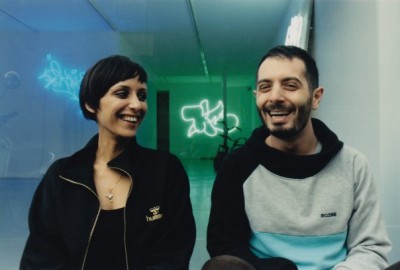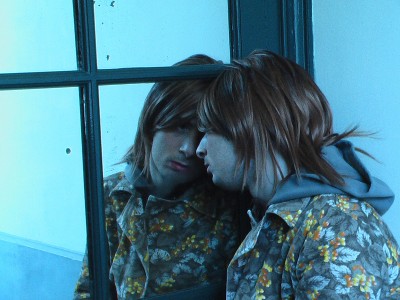biriken is the five year old interdisciplinary, collaborative project of Melis Tezkan and Okan Urun. Working at the intersection of performance art, installation art, and traditional theater practice, Tezkan and Urun exploit their divergent backgrounds—she studied media and communication and has worked extensively in video production, while he studied theater and acting—to create performative works that, in the Brechtian tradition, draw attention to the constructed nature of reality both within and outside of the performance space. In their projects, live performance mixes freely with projected video, looped audio, and/or textual elements, leveling the playing field between sensory experiences and representational techniques. “We use actors and video at the same time,” Ukun explains. “The actor for us is not more important than the video, or the video than the actor. The text is not more important than another element. Everything is important or not important. This co-existence of the video and the actor and the text—we hope—is less theatrical, less hierarchical.”
Though they first met as teenagers growing up in Istanbul, attending the same “weekend school” (the classes Turkish high school students take to prepare for college), biriken was actually born in Paris, where Tezkan and Urun reconnected as graduate students attending La Sorbonne, where he studied theater and acting and she continues to work towards her doctorate in aesthetics. After months spend discussing their art and their shared social, political, and intellectual concerns, “we said, ‘okay, instead of talking let’s do something together, and do something different,’” recalls Tezkan. This was in 2005. In 2006, when they collaborated on their first project, Simdi bizim evin yerinde cukur var (“Now there is a hole where once stood our house”), they realized they needed a name. In Turkish “biriken” means “accumulated” or “built-up.” “This was the idea—instead of talking, accumulating ideas,” they would create art out of their built-up thoughts and plans.
As it happens, this concept of working with a mass of accumulated materials applies not only to the duo’s use of their amassed conversations and schemes, but also their practice of drawing on the cultural baggage of their generation. “Our generation is the MTV generation,” says Urun. “It’s also our common point with the world. I think sometimes I feel more comfortable talking about something common then trying to explain local things to everyone.” Thus their projects are littered with references culled from across the pop cultural landscape of the past thirty years. For example, in Now there is a hole where once stood our house, Stacey Q’s 1985 hit single “Two of Hearts” provides the soundtrack to Urun’s live performance, in which he maniacally shifts between Jazzercise-style and Flashdance era dance moves and moments of intense, almost paranoid introspection. A projected video of Urun, jogging through the streets of Paris, fills the wall behind him; downstage, two small television sets show a live feed from a video camera set up on stage that records his movements about the stage.
In their second project, People As Places As People, Tezkan and Urun, inspired by a monologue from Jim Jarmusch’s 1980 film Permanent Vacation in which the main character describes people as “a series of rooms,” investigated the notion of “space” — space as a physical location, the virtual space of the Internet, space as the interior of the human mind and spirit. The project mixes audio of the monologue from the Jarmusch film with Nirvana’s 1993 single “All Apologies.” Further accompanying the audio is projection from a website being built through contributions made by the viewing audience regarding the performance as they experience it. All takes place within the context of a space filled with personal objects—an unmade bed, picture-frame lined shelves, more television sets—to create feeling of recent abandonment.
The purpose, for biriken, in mining the culture of their childhood is to use their art practice as a way to make sense of the political and social realities of their generation, realities from which they felt largely removed as children and young adults. “Our generation in Turkey, in Istanbul, and also in France, we are in a protected bubble,” explain Tezkan. “Yes, we are seeing all this information [on television] but we are not so political.” Though, like their peers in countries around the world, they watched the events of the wars in Iraq and Bosnia-Herzogovena on television, these conflicts seemed unreal to them, as did the military conflict being waged within Turkey itself between the Turkish government and Kurdish separatist groups based in the eastern region of the country. Urun describes the sense of distance he felt from these events as “horrible, the most horrible thing that somebody could do,” because of the false reality created for those living outside the war zones. Because television programs–especially music videos, but also children’s programs, the melodrama of soap operas, exercise programs–were the primary means by which this distance, this false reality, was maintained, Tezkan and Urun feel compelled to use these materials as the primary sources of their artworks.
Continuing with their exploration of Turkish society through the tropes of popular culture, biriken has most recently completed a new video work to be shown next month at Neurotitan in Berlin in an exhibition of young Turkish artists called Destroy Istanbul, curated by the Turkish art and culture magazine Bant. The new work, titled To Tina/What’s Love Got To Do With It?, features the mise en scène of the original video, but in the place of Turner it features the well-known Turkish actress Ayça Damgacı (with whom Tezkan and Urun have collaborated in the past) wandering the streets of Istanbul, mulling over the question posed the song, not only for herself “but for the people of Turkey now.” Tezkan and Urun make use of Damgacı’s strong public persona (the actress is best known outside of Turkey for her starring role in Gitmek: My Marlon and Brando, which recounts the true story of Damgacı’s travel across Turkey during the early phase of the 2003 Iraq War to rescue her love, a Kurdish actor who is trapped behind the border) to explore the fragility and heartbreak that often lie behind such seemingly impenetrable exteriors. As Tezkan puts it, “People have this image of powerful people, but they are really very emotional. So we are trying to see the situation and try to understand, what has love got to do with it?”
Summing up biriken’s work, Tezkan says, laughing, “It can sound a bit pretentious, but I think we are doing something new. Not because we use some video or audio work, but because we are looking at things with a new mentality, because we are young. We are bringing with us something else.”







